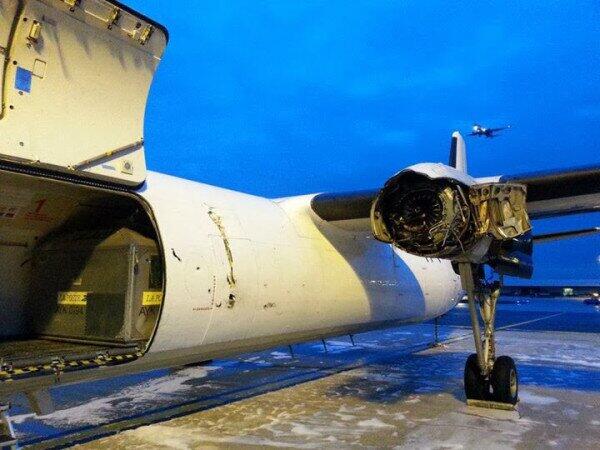
| Status: | Final |
| Date: | Friday 25 October 2013 |
| Time: | 01:25 |
| Type: | Fokker F-27 Friendship 500F |
| Operated by: | Miniliner |
| On behalf of: | Europe Airpost |
| Registration: | I-MLVT |
| C/n / msn: | 10373 |
| First flight: | 1968-10-04 (45 years 1 months) |
| Engines: | 2 Rolls-Royce Dart 532-7 |
| Crew: | Fatalities: 0 / Occupants: 2 |
| Passengers: | Fatalities: 0 / Occupants: 0 |
| Total: | Fatalities: 0 / Occupants: 2 |
| Airplane damage: | Substantial |
| Airplane fate: | Written off (damaged beyond repair) |
| Location: | Paris-Charles de Gaulle Airport (CDG) ( France) |
| Phase: | Initial climb (ICL) |
| Nature: | Cargo |
| Departure airport: | Paris-Charles de Gaulle Airport (CDG/LFPG), France |
| Dole-Jura Airport (DLE/LFGJ), France | |
| Flightnumber: | 5921 |
A Fokker F-27 cargo plane was damaged in an accident near Paris-Charles de Gaulle Airport (CDG), France.
Europe Airpost flight FPO5921 departed Paris-Charles de Gaulle Airport (CDG), France at 01:22 hours local time on a regular night time mail flight to Dole-Jura Airport (DLE), France.
While climbing through an altitude of 1300 feet, the flight crew heard the sound of an explosion from the cargo hold. Visual and aural alarms warned the crew about an issue with the left hand (no. 1) Rolls-Royce Dart 532-7 engine.
They declared an emergency and attempted to activated the fire extinguisher on the no.1 engine. However, this switch was blocked. The captain looked out the window and observed that the fire had stopped and the left engine was partially missing. The plane remained controllable and the crew turned back and landed without any further problems at Paris-Charles de Gaulle Airport. The forward portion of the left engine and the multi-split propeller were found in a field beneath the initial climb centreline of runway 09R.
Probable Cause:
Fatigue failure of the blade root
The no. 2 propeller blade root on the left engine failed due to fatigue, resulting in separation from the propeller hub and then interaction with the no. 1 blade and its disconnection from the propeller hub. The imbalance created by the loss of these two blades led to the front part of the engine being torn off.
The cause of the fatigue cracking could not be determined with certainty.
The following may have contributed to the fatigue fracture of the propeller blade root:
- insufficient preloading of the propeller, increasing the stress exerted on it. The lack of maintenance documentation made it impossible to determine the preload values of the bearings during the last general overhaul;
- the presence of manganese sulphide in a heavily charged area of the propeller. The presence of this sulphide may have generated a significant stress concentration factor, raising the local stress level.
The tests and research carried out as part of this investigation show that the propeller blade root is made of a steel whose microstructure and composition are not optimal for fatigue resistance. However, the uniqueness of the rupture more than 50 years after commissioning makes it unlikely that the rate of inclusions, their distribution, size, or sulphur content of the propeller is a contributing factor in the accident.




Ingen kommentarer:
Legg inn en kommentar
Merk: Bare medlemmer av denne bloggen kan legge inn en kommentar.